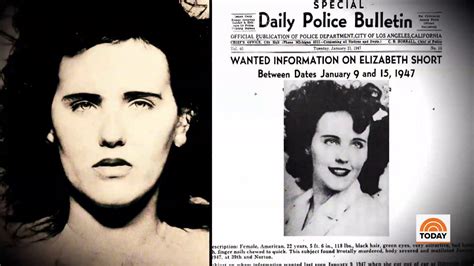The Elizabeth Short murder, notoriously known as the “Black Dahlia” case, has become an enduring symbol of the darker side of human nature and the complexities of criminal investigations. The case, which unfolded in Los Angeles in 1947, involved the gruesome murder of a 22-year-old woman, Elizabeth Ann Short, whose body was found mutilated and abandoned in a vacant lot. The brutality of the crime and the lack of progress in identifying the perpetrator have captivated the public’s imagination, inspiring countless theories, books, and films. This article delves into the investigation insights, exploring the methods used, the challenges faced, and the lessons learned from one of the most infamous unsolved murders in American history.
Introduction to the Case
Elizabeth Short’s life was marked by a quest for stardom in Hollywood, a dream shared by many young women who flocked to Los Angeles with aspirations of becoming movie stars. Her murder sent shockwaves through the community, not only because of its brutal nature but also due to the striking contrast between the glamour of Hollywood and the darkness of the crime. The investigation that followed was extensive, involving hundreds of leads, suspects, and pieces of evidence. However, despite these efforts, the case remains unsolved, leaving behind a legacy of intrigue and speculation.
Early Investigation: Challenges and Missteps
The initial investigation was conducted by the Los Angeles Police Department (LAPD), with Detective Harry Hansen leading the case. The LAPD faced numerous challenges, including the lack of forensic technology that is commonplace today. The crime scene was thoroughly examined, but many potential pieces of evidence were likely contaminated or overlooked due to the limitations of the time. Moreover, the LAPD was criticized for its handling of the investigation, with some arguing that the department was ill-equipped to deal with a case of such complexity and brutality.
One of the significant missteps in the early investigation was the failure to secure the crime scene properly, which might have compromised evidence. Additionally, the police were inundated with confessions, many of which were false and wasted valuable resources. The public’s fascination with the case also posed challenges, as the media scrutiny and the resulting public pressure likely influenced the investigation’s direction and the decisions made by the LAPD.
Investigative Techniques: Then and Now
The investigative techniques used in the Elizabeth Short murder case were largely based on traditional policing methods, including interviews, surveillance, and forensic analysis, albeit with much less sophistication than what is available today. The lack of DNA analysis, digital forensics, and other modern tools significantly hindered the investigation. In contrast, contemporary investigations rely heavily on these technologies, along with advanced psychological profiling and data analysis, which can significantly improve the chances of solving crimes.
Despite these advancements, the Elizabeth Short case highlights the importance of meticulous police work, thorough evidence collection, and the need for a systematic approach to investigation. It also underscores the challenges of solving crimes that are decades old, where evidence may have been lost, contaminated, or destroyed, and where witnesses may no longer be alive or able to recall crucial details.
Psychological Profiling: A Modern Perspective
Psychological profiling has become a critical tool in modern criminal investigations, allowing law enforcement to create detailed portraits of potential suspects based on the nature of the crime. In the context of the Elizabeth Short murder, applying modern profiling techniques could offer new insights into the mind and motivations of the killer. This might involve analyzing the crime scene for signs of ritualistic behavior, controlling tendencies, or other psychological indicators that could help identify the type of individual who might commit such a heinous act.
However, it’s crucial to note that profiling is not a science but rather an art that relies on the profiler’s experience and understanding of human psychology. Its application to cold cases like the Black Dahlia murder is speculative and should be approached with caution, considering the risk of false leads and the potential for misleading the investigation.
Public Engagement and the Role of Media
The media played a pivotal role in the Elizabeth Short case, both in terms of raising public awareness and potentially interfering with the investigation. The sensationalized coverage of the crime and its gruesome details captivated the nation, turning the case into a morbid spectacle. While the media attention helped keep the case in the public eye, it also created challenges for the investigators, who had to navigate a complex web of rumors, misinformation, and public expectations.
Today, the role of media in criminal investigations is more nuanced, with social media platforms offering both opportunities and challenges. On one hand, social media can be a powerful tool for disseminating information and gathering tips from the public. On the other hand, it can spread misinformation rapidly and exert undue pressure on investigators, potentially compromising the integrity of the investigation.
FAQ Section
What were some of the challenges faced by the LAPD during the initial investigation of the Elizabeth Short murder?
+The LAPD faced several challenges, including the lack of forensic technology, contamination of the crime scene, and the overwhelming number of false confessions and leads. Additionally, the department was under significant public and media pressure to solve the case, which could have influenced the direction of the investigation.
How does the Elizabeth Short case illustrate the importance of preserving evidence and securing crime scenes?
+The case highlights the critical importance of meticulous evidence preservation and crime scene security. The failure to properly secure the area where Elizabeth Short's body was found likely resulted in the loss or contamination of potential evidence, which could have been crucial in identifying the perpetrator and solving the case.
What role can psychological profiling play in solving cold cases like the Elizabeth Short murder?
+Psychological profiling can offer insights into the type of individual who might commit a crime based on the nature of the act. However, its application to cold cases should be cautious and considered speculative, as it relies on the profiler's expertise and understanding of human psychology. Profiling can generate leads but should be used in conjunction with other investigative techniques.
Conclusion: Lessons from the Past
The Elizabeth Short murder case serves as a stark reminder of the complexities and challenges inherent in criminal investigations. It underscores the importance of meticulous evidence collection, the preservation of crime scenes, and the careful consideration of all leads and theories. The case also highlights the evolving nature of investigative techniques, from the traditional methods employed in 1947 to the sophisticated forensic and psychological tools available today.
As we reflect on the Elizabeth Short case, it’s clear that solving crimes, especially those as brutal and complex as this one, requires a combination of advanced technology, thorough investigative work, and a deep understanding of human psychology. The Black Dahlia case will likely remain a fascinating, albeit tragic, chapter in the history of criminal investigations, serving as a reminder of the darker aspects of human nature and the enduring quest for justice.



